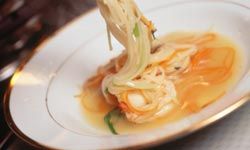If you've ever stretched $10 over a week, you know ramen noodles. Whether you're a poor student, a starving actor or simply on a tight budget, ramen noodles are a culinary staple.
So what is this "delicacy" and where did we get it? Ramen is an egg noodle dish, served in a soup broth of meat and vegetables. Long before it was an integral part of dorm life in the U.S., Chinese cooks were making ramen in Japan, starting in around 1910. This dish, combining Chinese noodles and Japanese broth, was first called shina soba, meaning "Chinese noodles."
Advertisement
Its popularity throughout Japan increased, but when post-World-War-II tensions between China and Japan escalated, "shina" was dropped to exclude any Chinese reference. Nissin Foods, the creator of instant ramen in 1958, took the nomenclature even further. Under the brand name Top Ramen, they renamed the product "Chikin Ramen." Chikin came from the chicken flavoring in the noodles. Ramen came from the Chinese words la mian, meaning "to pull noodles." The "L" and "R" sounds are interchangeable in Japanese, and the ramen name stuck.
So, what's the magic in these noodles, and why is it a household name? For starters, ramen noodles appeal to everything that modern culture loves -- they're quick, easy to make and cheap. Additionally, ramen is filling and tasty. So while ramen is popular with people with empty wallets, it's also a main ingredient in hundreds of recipes. Read on to discover how ramen can be more than just a cup of soup with our five recipes. The first one uses ramen in its natural state.


